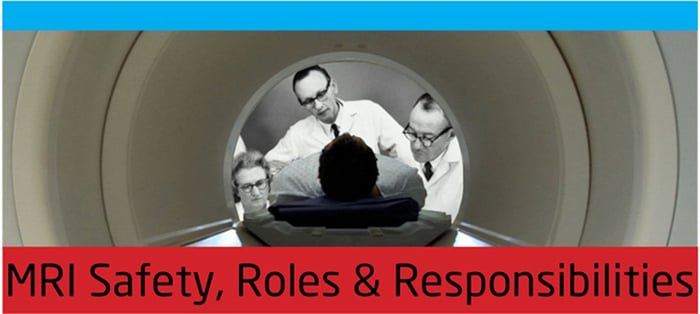Magnetic Resonance Imaging or MRI is the preferred procedure for diagnosing a wide variety of problems or conditions within the human body. Physicians can use the MRI to examine a large number of body parts including the brain, spine, joints, blood vessels, and other organs like the heart and lungs. The result of the MR scan is a very detailed image of organs and tissues throughout the body without the need for x-rays or “ionizing” radiation. To create these detailed images, the MRI uses a powerful magnetic field to align the protons that are present in most of the body’s tissues. Once applied, radio waves then cause these atomic particles to produce a signal that can be received by the MRI scanner. The computer inside the MRI collects the signal data from the rapidly changing magnetic field and assembles detailed images of the tissue that can be viewed from many different angles.
To insure safety around the highly technical and powerful MR scanners in both clinical and research settings, an international group of scientific and medical societies have drafted a recommended directive focused on the safety and operation of MR systems. The result of their collaboration details the roles and responsibilities for MR professionals who run imaging facilities and operate the MR systems. Their work is published in the Journal of Magnetic Resonance Imaging and seeks to define and limit the exposure to electric and magnetic fields for both patients and technologists.
The recommendations are applicable to both clinical and research MR settings. They represent the consensus of: the American Board of Magnetic Resonance Safety (ABMRS), the Society for Cardiovascular Magnetic Resonance (SCMR), the European Federation of Organizations in Medical Physics (EFOMP), the European Federation of Radiographer Societies(EFRS), the European Society for Magnetic Resonance in Medicine and Biology (ESMRMB), the European Society of Radiology (ESR), the International Society for Magnetic Resonance in Medicine (ISMRM), and the Section for Magnetic Resonance Technologists (SMRT).
Roles and Responsibilities
The following information is the recommended responsibilities for the management of MRI safety.
Magnetic Resonance Medical Director (MRMD)
Magnetic Resonance Research Director (MRRD)
The MRMD/MRRD is operationally and ultimately responsible for the MRI facility. It is expected that they are a physician or radiologist with the training/education to provide guidance, oversight and assume or assign operational responsibility during any MRI procedure.
The MRMD/MRRD responsibilities include:
- Overseeing the safe execution of the MRI examination on each and every patient/human subject examined in the MRI system(s) or MRI site(s) under his/her jurisdiction at all times and without exception. One MRMD/MRRD may preside over more than one MR system.
- Being available/accessible to the operators of the MRI system at all times during which the MR facility is accessible.
- Identifying at least one Magnetic Resonance Safety Expert (MRSE) who can advise, on an as-needed basis, regarding all matters and issues relating to MR safety.
- Designating at least one Magnetic Resonance Safety Officer (MRSO) for each MR system. A MRSO may preside over multiple MR systems.
- Staying current with specific policies and procedures pertaining to the safe operation of MR services.
- Making sure safety, quality assurance, and risk assessment programs are implemented.
- Appropriately investigating any incidents or safety related events and that the records are kept of these analyses.
Magnetic Resonance Safety Officer (MRSO)
The role of MRSO is typically performed by the senior MRI Technologist or Radiographer as assigned by the MRMD/MRRD. They are fluent in the operation and medical procedures involved with the MRI system.
MRSO responsibilities include:
- Being readily accessible and available to the operators of the MRI system at all times while the MR facility is accessible.
- Ensuring that proper policies and procedures for day-to-day MRI safety are enforced.
- Developing, documenting, and introducing safe working procedures for the MR environment.
- Ensuring that adequate written safety procedures, work instructions, emergency procedures, and operating instructions are issued to all concerned.
- Ensuring that appropriate measures for minimizing risks to health that arise from the use of or exposure to the MR equipment are implemented and monitored.
- Managing hazards posed by the MR equipment and monitoring the measures taken to protect against such hazards.
- Ensuring that all Heads of Departments and senior medical staff members who are responsible for personnel who will be involved with the MR system are informed of the formal procedures for training and authorization.
- Ensuring that medical, technical, nursing, and all other relevant staff groups (including ancillary workers) who may be exposed to the MR environment are educated appropriately on a regular basis as to the safety requirements and updated as necessary.
- Maintaining records of the personnel who have been educated appropriately as to the safety requirements.
- Consulting the MRMD/MRRD (and/or the MRSE) when further advice is required regarding MR safety.
- Ensuring that there is a clear policy for the purchasing, testing, and marking of all equipment that will be taken into the MR-related critical areas.
- Providing and/or ensuring the provision of MR safety education and training in cooperation with, and as per the policies of the MRMD/MRRD.
- Providing safety advice regarding the selection, procurement, and installation of MR-related equipment (in consultation with the MRSE, if/as needed).
- Providing safety advice on the modification of MR protocols (in consultation with the MRSE, if/as needed).
- Maintaining regular contact with other relevant groups or committees responsible for the safety and welfare of personnel on site, such as, but not limited to, the local ethics committee and the local safety committee.
Magnetic Resonance Safety Expert (MRSE)
This position is a more technical role and expected to serve as a resource in the operation and maintenance of the MR system. They no not need a medical education. Many MRSE will serve as an engineer or technician who is on call to provide technical assistance as needed.
MRSE responsibilities include:
- Giving high-level advice on the engineering, scientific, and administrative aspects of the safe use of MR equipment. The MRSE will also provide advice on the development and continuing evaluation of a safety framework for the MR environment.
- Developing rules and procedures to ensure the safe use of MRI equipment.
- Providing safety (including diagnostic effectiveness linked to safety) advice on the modification of MR protocols.
- Giving advice regarding non-routine MR procedures for individual subjects and specific subjects groups. This includes advice regarding safety related to implanted devices, metallic foreign bodies, tattoos, and other similar issues.
- Selecting MR Safety programs and MR Quality Assurance programs, and evaluations and audits thereof.
- Assistance with the selection, procurement, and installation of the MR system and related equipment, as well as on the quality control programs regarding their performance.
- Testing prior to use of the MR, advice regarding performance testing procedures and testing following any major maintenance procedure.
- Establish and maintain links with any appropriate district, regional, and/or professional bodies.
- Report back to the MRMD/MRRD any MR safety-related
At Atlantis Worldwide, we can provide you with information, insights and advice regarding the right refurbished MRI or used MRI system to fit your needs, budget and facility!
Talk to us today! Call Jeff Weiss at 212-366-9100 or jeffweiss@atlantisworldwide.com
Some blogs you may have missed:
- Most Common Artifacts in MRI
- Physicians & Social Media: Yay or Nay?
- 7 Benefits of Medical Imaging File Sharing
- Your Body Image: New Uses for DXA
- Can Your MRI Be Hacked?
- Free MRI Resources
About the author: Vikki Harmonay



